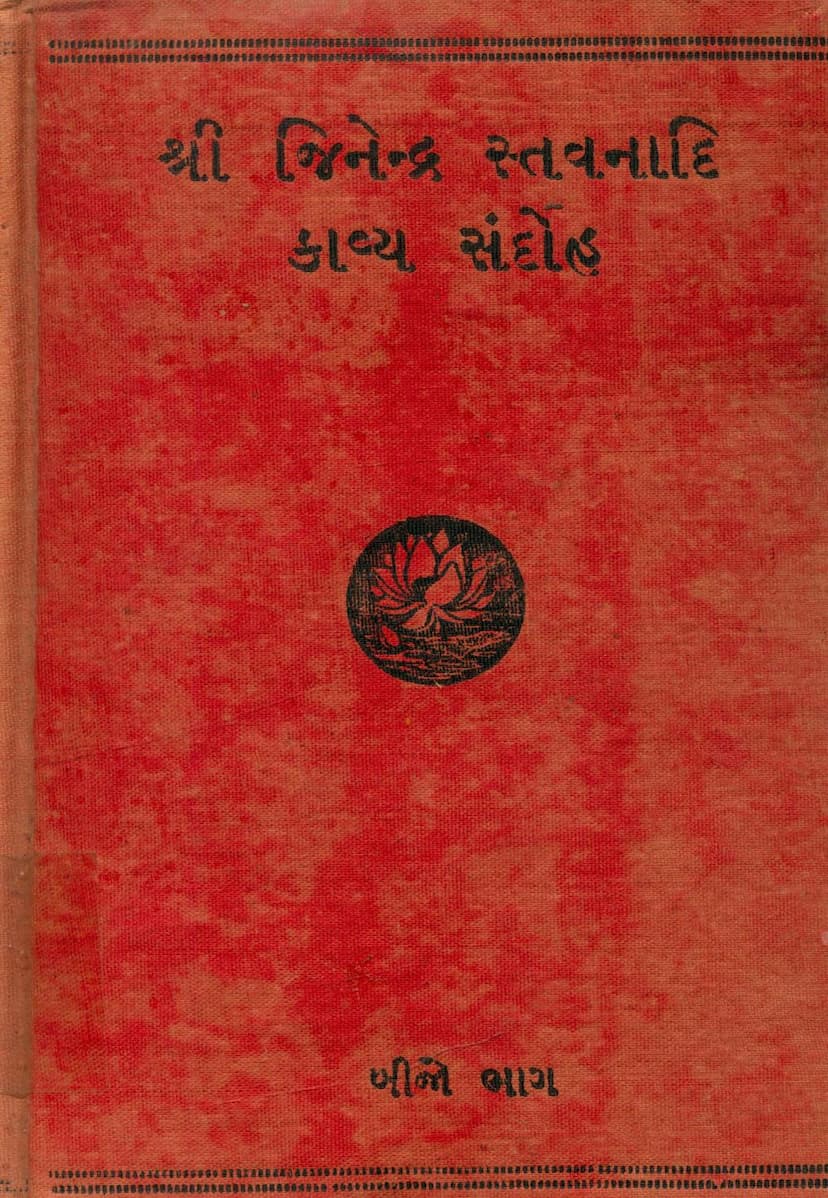Jinendra Stavanadi Kavya Sandoh Part 02
Added to library: September 2, 2025

Summary
This Jain text, "Jinendra Stavanadi Kavya Sandoh Part 02," is a collection of devotional poetry and hymns in Gujarati, compiled by revered Jain monks and scholars. The book, published by Shri Vijaydansuri Jain Granthmala, is the second part of a series dedicated to praising Lord Jinendra (Jain Tirthankaras).
Key features and contents of the book include:
-
Compilation and Authorship: The collection is attributed to "Prachin Maha Purush" (ancient great souls) and compiled by the esteemed scholar Upadhyayji Shri Charitravijayji Ganivar, a disciple of Acharyadev Shrimad Vijayramchandrasurishwarji Maharaj. The publication is under the auspices of Shri Vijaydansurishwarji Jain Granthmala.
-
Structure and Sections: The book is meticulously organized into eleven distinct sections, each containing various forms of devotional literature:
- Chaitra Vandan Chavisim (Section 1): This section presents the Chaitra Vandan (a form of veneration) for each of the 24 Tirthankaras, composed by Upadhyay Shri Manvijayji.
- Prakirna Chaitra Vandan (Section 2): This section includes miscellaneous Chaitra Vandans, covering various Tirthankaras, specific sites like Shankheshwar Parshwanath, and festivals like Diwali.
- Stavan Visi Sangrah (Section 3): This section contains collections of Stavans (hymns or praises), including a series of twenty Stavans by Shri Jeevanvijayji and another by Shri Danvijayji, each praising the 24 Tirthankaras.
- Prakirna Stavane (Section 4): This section offers a diverse range of miscellaneous Stavans, including those dedicated to specific Tirthankaras, holy sites like Shatrunjay Giriraj, and descriptions of their life events (Kalyanaks).
- Stuti Chaturshak (Section 5): This section presents Stuti Chaturshaks (sets of four praises) for the 24 Tirthankaras, highlighting their virtues and divine attributes.
- Prakirna Stuti Chaturshak (Section 6): This section includes miscellaneous Stuti Chaturshaks, some praising specific Tirthankaras, others focusing on universal Jain principles.
- Stuti Chatushkatmak Stuti Sangrah (Section 7): This section provides a collection of Stuti Chatushkatmak (four-part praises), with individual sections dedicated to specific Tirthankaras like Simandhar Swami.
- Prakirna Stuties (Section 8): This section contains a variety of miscellaneous praises, often focusing on specific aspects of Tirthankaras or Jain practices.
- Sajhay Sangrah (Section 9): This section features Sajhay (devotional songs or narratives), including those on the virtues of Shil (conduct), the lives of 63 Shalaka Purushas, the story of Dhanna and Shalibhadra, and descriptions of festivals like Paryushan.
- Shri Ganadhar Devavandan (Section 10): This section details the rituals and hymns for venerating the Ganadhars (chief disciples of Tirthankaras), providing specific guidance for different times of the year and including prayers like Namaskara Mahamantra.
- Shri Ashtaprakari Puja no Ras (Section 11): This section is a lengthy and detailed narrative Ras (a poetic ballad or song) describing the Ashtaprakari Puja (eightfold worship) of Lord Mahavir. It includes stories illustrating the significance of each step of the ritual, like the story of Madanavati and the significance of incense (dhup).
-
Purpose of Stavana (Praise): The "Sangrah-Sanjak-nu-Samvedan" (The Compiler's Reflection) section explains the three purposes of Stavana: Arthasiddhi (achieving worldly or spiritual goals), Krutadnyata (expressing gratitude), and Manaprasannata (finding joy and peace in the heart). It emphasizes that while all three are valid, the highest form of praise is done purely for the pleasure of the praised, seeing their inherent goodness. The text strongly advocates for praising Lord Jinendra as the ultimate object of devotion, as His teachings lead to liberation from suffering.
-
Philosophical Underpinnings: The text delves into the philosophy of devotion in Jainism, explaining that true worship aims for spiritual liberation. It discourages attachment to worldly outcomes from devotion, promoting instead a focus on the inherent virtues of the Tirthankaras. The importance of proper understanding of the object of worship (Stavaniya-sambandhi nirnay) is highlighted for the efficacy of Stavana.
-
Historical Context: The book mentions the first part was published in V.S. 2004 (Vikram Samvat) and this second part in V.S. 2013 (Vikram Samvat) or 1957 CE, with an initial print run of 3000 copies. It also pays homage to the esteemed gurus of the lineage, particularly Acharya Shri Vijaydan Surishwarji Maharaj and Acharya Shri Vijay Prem Surishwarji Maharaj.
-
Language and Style: The text is written in Gujarati, employing a devotional and poetic style. It uses rich vocabulary and meter to convey deep reverence and spiritual sentiment.
In essence, "Jinendra Stavanadi Kavya Sandoh Part 02" is a valuable repository of Jain devotional literature, offering a comprehensive collection of prayers, hymns, and narratives aimed at fostering spiritual connection, gratitude, and inner peace through the worship of Lord Jinendra.